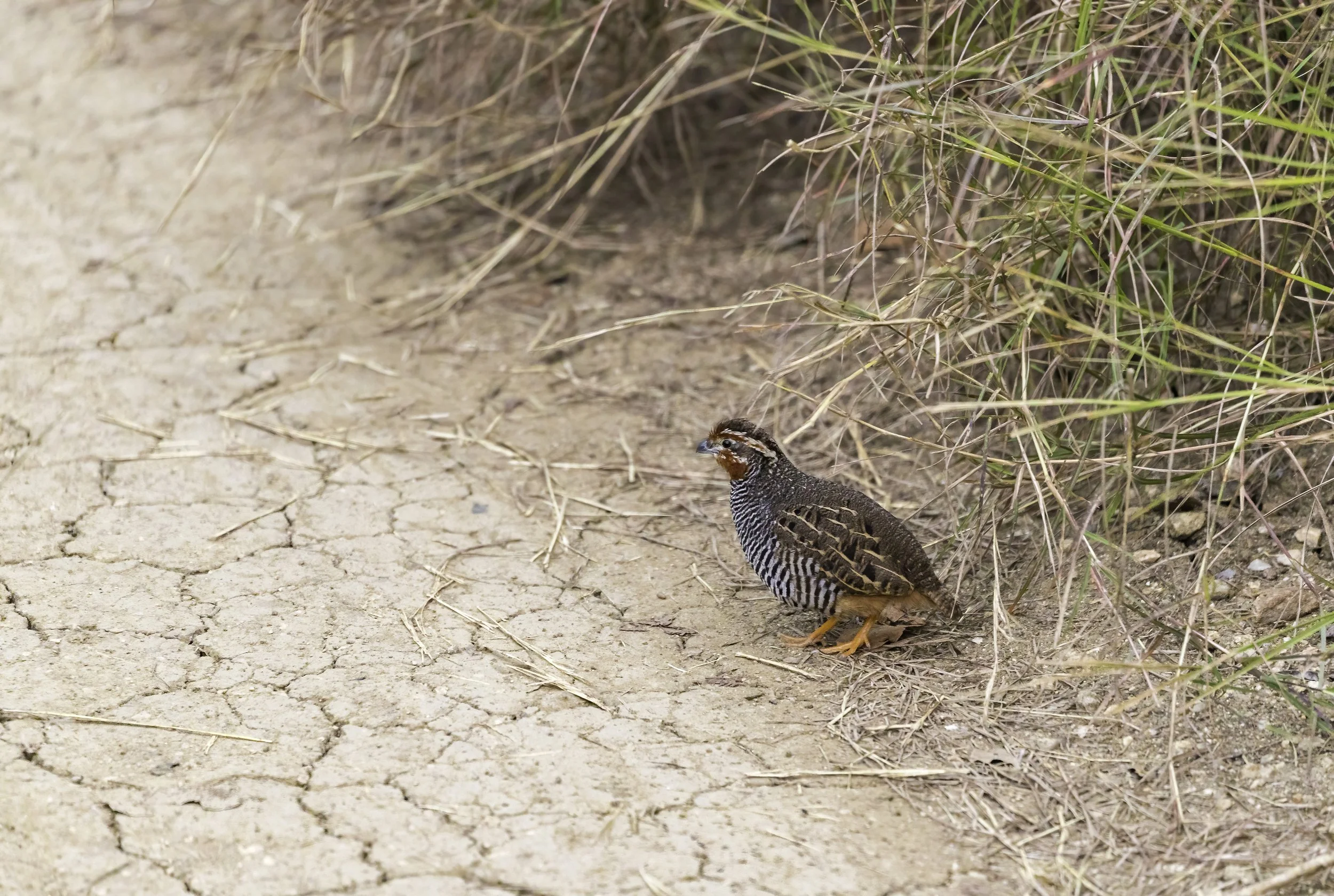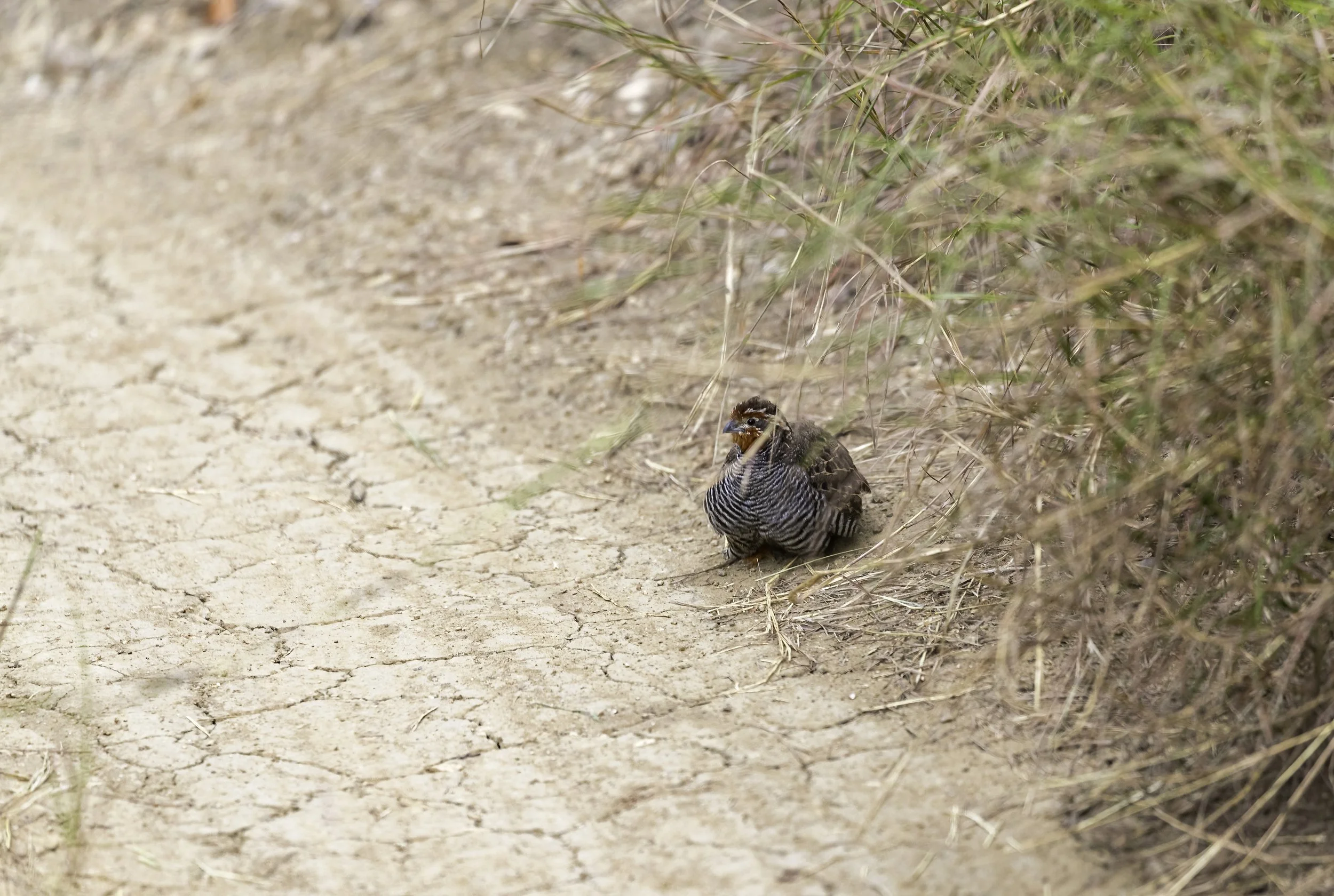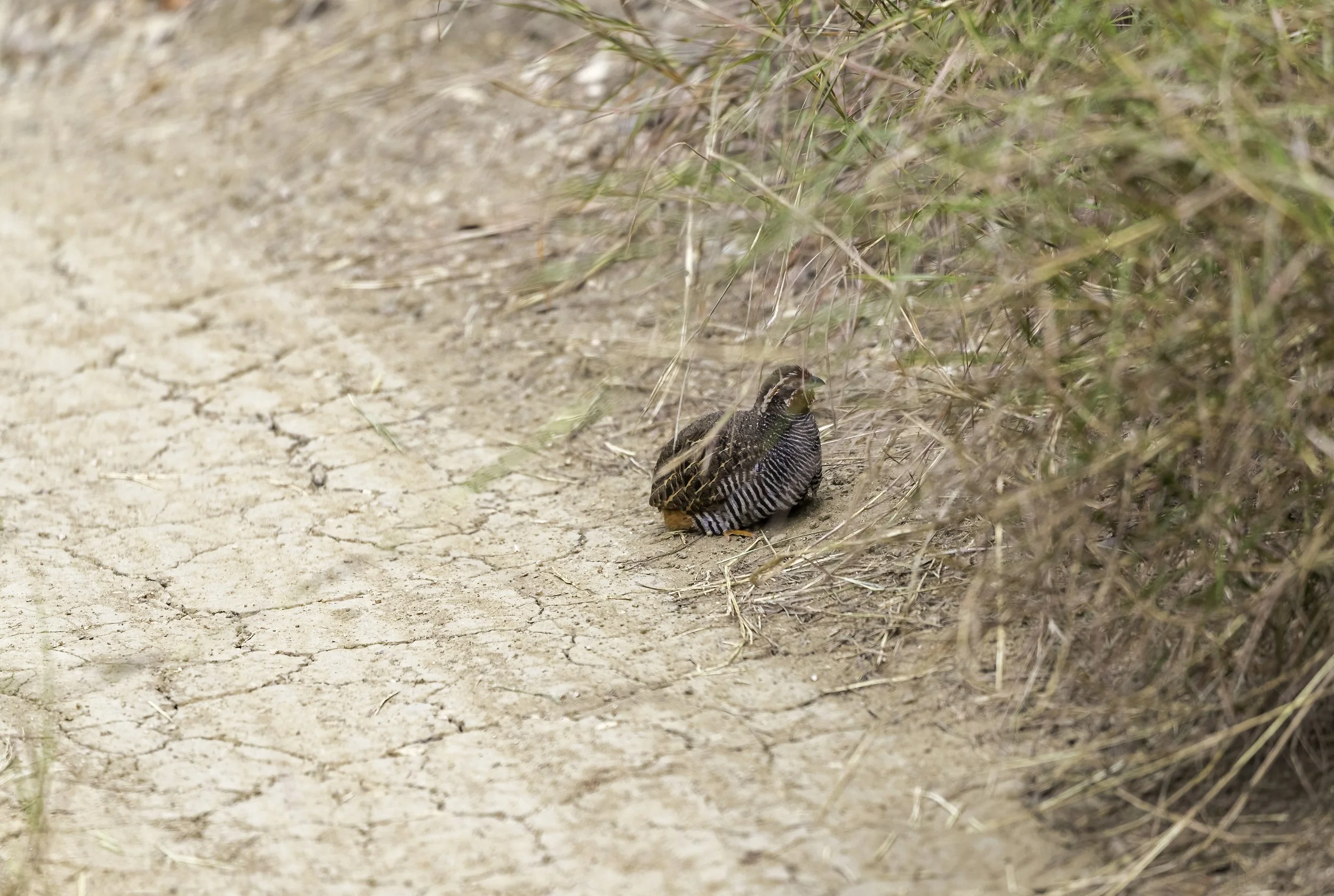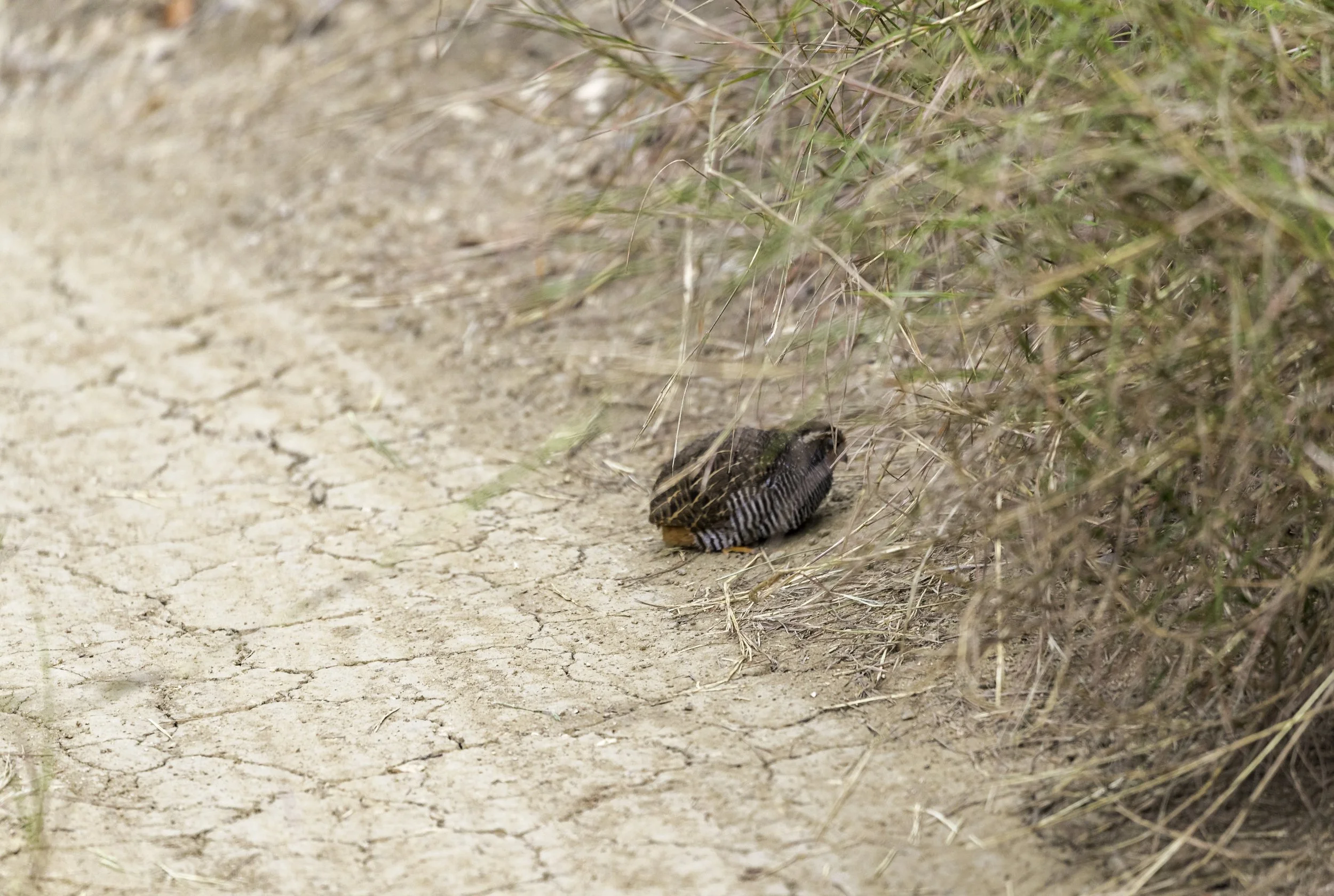Jungle Bush Quail
Perdicula asiatica
Pench National Park
Today it is about a few surprising and intimate moments spent with a beautiful Jungle Bush Quail in the stunning Khursapar range of the Pench National Park which is set in a flourishing teak jungle, home to various wildlife species, including tigers and dhole. Pench National Park is a spectacular natural reserve, with typical teak jungles common to central India, offering a quiet and secluded game viewing experience.
Taking its name from the meandering Pench River, which intersects the park, the reserve sprawls over a breathtaking landscape of hills, forests and valleys. Coupled with the feeling of having the entire forest to yourself, the gentle, undulating scenery of the Satpura Hills creates an unforgettable jungle experience. The mosaic of vegetation, from lush valleys to dry, deciduous forests, creates a range of habitats for India’s exotic wildlife.
I have also spotted the Jungle Bush Quail in beautiful Tadoba where, early in the day, the sun follows one like a lodestar through the tangled heads of the trees and as the day progresses it burns with a blinding exquisiteness that makes us shield our eyes and bless our existence. The light is lustrous in the open spaces and seemed undistllled from heaven to earth, seeming like a laser show at times, as gem clear beams filter through the trees. The warmth of it settles over our faces like a silken mask and life is a golden joy. That is the thing about the seraph-light of this jungle; it can sweep down like the handloom of the gods one moment, pure and clear and long of line.
Pench National Park
Pench National Park, nestled in the heart of India in the lower southern reaches of the Satpura hills, sprawls a massive 758 km² across the states of Madhya Pradesh & Maharashtra. In Madhya Pradesh it is located in the districts of Seoni and Chhindwara. Named after the pristine River Pench it was immortalised by Rudyard Kipling in his Jungle Book. Every year millions make their way here to spot Akela (the Indian Wolf), Baloo (the Sloth Bear), Bagheera (the Black Panther) and Shere Khan (the Royal Bengal Tiger). It was declared a sanctuary in 1965 and elevated to the status of national park in 1975 and enlisted as a tiger reserve in 1992. The area has always been rich in wildlife dominated by fairly open canopy, mixed forests with considerable shrub cover and open grassy patches. The high habitat heterogeneity favours a high population of Chital and Sambhar. Pench tiger reserve has highest density of herbivores in India (90.3 animals per km²).
Pench has a glorious history of natural wealth and unique cultural richness described in several classics ranging from the Ain-e-Akbari to the Jungle Book. Several natural history books like Strendale’s “Seonee - Camplife in the Satpuras” & Forsyth’s “Highlands of Central India” present a detailed panorama of these forests.
The forest, lush and green in the monsoon, also harbours a wide range of faunal species some of which figure prominently in the IUCN Red List. Our story, however, revolves around a spectacular young leopard who is frequently spotted in the small hills and well-stocked teak mixed forest of the Khursapar range.
Pench National Park also was the location used by the BBC for the innovative wildlife series Tiger: Spy in the Jungle, a three-part documentary narrated by Sir David Attenborough which used concealed cameras, placed by elephants, in order to capture intimate tiger behaviour and also retrieved footage of various other fauna in the reserve. The programme aired for the first time in March 2008 and ended a month later.
The Khursapar Range
Sometime in the mid of 2012 the Supreme Court passed an order that sought a directive to the States to notify the buffer and peripheral areas of the tiger reserves, under the Wildlife (Protection) Act, to prevent tourism in the core areas. But after a lot of debate by various associations and state governments the court revised the order and said that tourism will be allowed but with restrictions in place. The impact of all these decisions was that the total number of vehicle permitted from the Park Core gates was reduced by 50%.
This created a major problem as the roads from the other distant gates were not in the best of shape so an exercise was undertaken to trace a road which connected the Sillari forest gate to the Whakari forest gate and was brought to the notice of the then, very dynamic and forward thinking, PCCF & DFO who actively worked and created what became known as the Khursapar forest Range. Towards the end of November 2014, I think, the Khursapar forest gate was officially opened as the buffer area of Pench National Park, Maharashtra catering to 11 safari vehicles.
But there were some teething issues as the forest area was used for grazing and also as a gateway to Pench dam for illegal fishing. The hilly terrain, almost continuous human activity and paucity of water the density of wildlife was very low. Big cats like tigers and leopards were almost never seen and even when spotted they didn’t stick around for long. Finally the local fishermen lobbied against the creation of the buffer zone.
It was not all negative though and there were advantages too like the proximity of the gate to the primary tourist facilities of Kohka & Turia. The experience of the safari itself was among the best given the lush green forests and these soon had the Forest Department taking action and a proper gate was built. A tourist center with washrooms was also included at the gate. Strategic water holes were incorporated to alleviate the water scarcity and the number of vehicles allowed was also increased. And gradually over the years the range developed into a beautiful habitat with a good number of tigers making it their home. Some notable tigers are Durga, Bindu, Baras, Handsome and they’ve also brought their families up energising the entire range along with numerous leopards, dhole, bears, gaur, chital, sambhar and the list goes on. Kudos to the people from around the area who contributed immensely with the help of the forest department to make this a beautiful part of the larger Pench National Park.
‡‡‡‡‡
Read about my tigers from Central and South India
For more on the wildlife of Pench click the button below.
‡‡‡‡‡
In the short window of time I got with the quail, I was able to record this short clip before it went back into the undergrowth. The video has no audio as there wasn’t enough time.
Jungle Bush Quail
My encounter with this bush quail was very surprising. We were tracking a tigress and waiting for her to make her way out of the dense undergrowth when this little bush quail popped out just before us. This is the lowest angle I could work from our safari gypsy as it is unsafe to step out of the vehicle in the jungle.
The jungle bush quail (Perdicula asiatica) is a species of quail native to the Indian Subcontinent in the family Phasianidae. it is found throughout peninsular India north to Gujarat, Odisha, and the Kashmir foothills, along with Sri Lanka. It has also been reported from Nepal, but has not been recorded there since the 19th century. It was introduced to Réunion around 1850 and to Mauritius around 1860, but the species is now locally extinct on the latter island.
It is a small species of quail about 15–18 cm long and weighing 57–82 grams. It shows significant sexual dimorphism with males having brown upperparts with blackish and buff marking & whitish underparts with black barring. The face is mainly dark reddish-brown, with brown ear-coverts, a buffy-white moustachial stripe, and the supercilium turning whitish towards the back of the neck. The females have a similar pattern, but with pinkish-brown underparts, more uniform wings, and duller moustachial stripes.
The species inhabits dry areas with shrubby or rocky cover, in habitats ranging from thin grasslands to dense deciduous forests. It is found at elevations up to 1,200 m (3,900 ft), but at elevations up to 1,500 m (4,900 ft) in the Western Ghats and southern India. It is generally non-migratory, but is possibly a migrant in Nepal. It feeds on seeds and small insects, typically in small groups of 6–25 birds. Breeding starts at the end of the rains and lasts until the end of the cold season, with the exact timing varying across its range. It nests in shallow scrapes in cover and lays clutches of 4–8 eggs. Incubation is only done by the female. The International Union for Conservation of Nature considers the jungle bush quail to be of least concern due to its large range and stable population.
There are five recognised subspecies of the jungle bush quail:
P. a. asiatica (Latham, 1790): The nominate subspecies, it is found in north and central India.
P. a. vidali Whistler & Kinnear, 1936: Found in southwest India, it has more reddish upperparts than the nominate subspecies, especially on the top of the head, and has broader barring on the underparts in males.
P. a. ceylonensis Whistler & Kinnear, 1936: Found on Sri Lanka. Its upperparts and throat are much darker than those of other subspecies and its underparts contrast less strongly with the upperparts.
P. a. punjaubi Whistler, 1939: Also known as the Punjab jungle bush quail, it is found in northwestern India. It is paler than the nominate subspecies, with sandier upperparts with less noticeable black markings.
P. a. vellorei Abdulali & Reuben, 1965: Found in south India.
The jungle bush quail is listed as being of least concern by the International Union for Conservation of Nature (IUCN) on the IUCN Red List due to its large range and stable population. It is generally common throughout India, although it is reported to be uncommon in Kerala, and locally in extinct in parts of Gujarat and in Uttara Kannada, Karnataka. In Sri Lanka, it was reportedly common until the 1950's, but is now only locally plentiful in the hills of the Uva Province. It has not been reported from Nepal since the 19th century, and reports from there and Cachar in Assam may be erroneous. The introduced population on Réunion is declining but still locally common, while the one on Mauritius is extinct. The jungle bush quail is hunted for food in rural regions.
Now onto some photos from the brief encounter with this wonderful bird as it hopped out onto the track, rummaged around in the dirt for a few seconds and then went back into the grass.
‡‡‡‡‡
Related Posts













